NAIOP San Diego, the Commercial Real Estate Development Association, convened a panel of San Diego’s leading life science real estate developers last week at the San Diego Marriott Del Mar to discuss the opportunities and challenges facing the local life science industry and development companies that create real estate spaces for life science firms.
Following discussion about the tight market for acquiring and originating life science property in San Diego and other national life science markets, moderator Chad Urie from global real estate services firm JLL asked panel members to speculate about where the local life science industry might expand if the city’s latest niche market, Sorrento Mesa, fills to capacity like Torrey Pines and University Towne Center (UTC).
“I think it could be downtown,” answered Jeff Graham, executive director, real estate at UCSD. In the mid-2000s, blocks in the East Village were set aside for the life sciences. “There are still blocks that would be ideal for life science,” Graham said, adding. “All the infrastructure is in place and the entitlement process is easier.”
Others are eyeing markets further north. “We would look at Carlsbad when they [life sciences firms] mature out of the R&D phase,” said Steve Bollert, CEO of BioScience Properties, Inc., a local, entrepreneurial real estate investment and development firm. Dan Ryan, CIO at Alexandria Real Estate Equities, a major real estate investment trust specializing in life science, technology and agtech properties, added that “Del Mar Heights is intriguing.”
When asked about comparing San Diego’s 2.7 million rentable square feet of current life science demand to Boston’s life science demand of 3.1 million, the panelists identified Boston’s superiority with its strength in financially stable life science companies and better access to C-level talent.
Referring to Boston and San Francisco, Phase 3 Real Estate Partners, a local real estate company specializing in life science properties, CEO Neil Fox said, “San Diego life science companies don’t have the strong capital resources that other areas do.” Ryan further explained limited access to C-Level talent with, “We don’t have the depth of experience in CEOs, CFOs and senior scientists here in San Diego.”
The panelists also brought up rising construction costs, drug regulation and healthcare reform as risk factors to the growth of San Diego’s life science industry.
Ryan advised the audience of real estate professionals, “The way we counteract risks is by telling our story … and reinforcing the San Diego brand. You may not think that it is relevant to what we do day-to-day, but know your statistics.” He highlighted UCSD’s number of life science graduates — a majority of whom are women — and the world-renowned research institutes that could open the door to public-private partnerships that would strengthen the overall industry. “We have great community, and we all carry that San Diego torch.”
About NAIOP San Diego
NAIOP San Diego is a chapter of NAIOP, the Commercial Real Estate Development Association, and it comprises more than 750 members serving the local San Diego market. NAIOP is the leading organization for developers, owners and related professionals in office, industrial and mixed use/retail real estate, with 19,000 members in North America. NAIOP advances responsible commercial real estate development and advocates for effective public policy. For more information, visit www.naiopsd.org.

